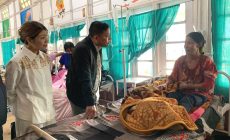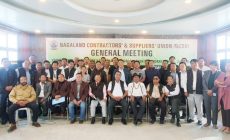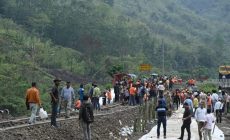Morung Express News
Dimapur | October 24
The greatest impact of Christian mission intervention was education that Nagas received, opined Dr G Kanato Chophy, delivering the 17th Morung Lecture on October 22 at The Lighthouse Church, Dimapur.
In retrospection, education transformed Naga society amidst various debates over the impact of Christian mission works and Christianity, he stated in the lecture, ‘Impact of Christianity on Nagas – A Historical Perspective.’
However, the Social Anthropologist at Assam’s Dibrugarh University stressed that study and assessment of impact of Christianity among the Nagas is not monolithic, but is dynamic and evolving, with various regional dimensions.
In the intervening period, there were significant cultural interaction and debates including even friction between Christianity and traditional culture, he noted.
Accordingly, a holistic understanding of the dynamic impact involves going beyond 1872, and tracing Christian history in the Naga areas to the first instance of interaction way back in 1839, he implied.
It is pertinent to talk about how far we travelled and should be heading as we look forward to celebrating the 150 years of Christianity in Nagaland, he stressed.
Tracing the trajectory, Dr Kanato highlighted the significance of a Namsangia Naga chief inviting Miles Bronson to Namsang village, under Tirap District in the present Arunachal Pradesh in 1839, from historical and anthropological point of view.
In 1839, there was a thriving Neo-Vaishnavism, after a powerful Nocte chief embraced Hinduism in 17th century, but it “suffered a setback” as learning was restricted to only certain section of social hierarchy, as per his disposition.
Bronson, thus, was invited to start a school for the chief’s sons, he informed, opining that Christian missions had a distinct advantage because they were willing to translate the Bible into “any unknown tongue.”
Accordingly, Bronson prepared the first Naga primer in the “Namsangia Naga” language, but had to abandon the mission due to personal circumstances including bad health.
In retrospection, it takes a lot to know about how the mission intervention had played a very important role in the lives of the Nagas, he said, postulating that had the mission continued, the Noctes would have been “the most advanced Naga tribe and perhaps possibly determining the narrative who Nagas are, instead of the others.
‘Chosen one’ is education
Dr Kanato also attributed the emergence of the concept of “advanced” and “backward” tribes to such encounters, and called for taking such historical factors into account while analysing the present context.
Thus, the ramification of Mission ending in Namsang was big, he said, reiterating his argument that education has had been the greatest impact of Naga missionary encounter.
It is in this context, Dr Kanato called the notion of interesting “chosen one” misconception” among many Nagas as “ridiculous.”
‘What made us chosen or anybody chosen is education, he declared.
While there are many issues to discuss relating to missionary intervention or the whole Naga mission interaction such as culture wars or loss of cultures, education is not, he implied.
“I think one thing that that in retrospection which Nagas should be very thankful is that education,” he averred, adding that mission education has enabled and transformed Naga Society,
Perhaps, this should be the one of the biggest impact for me – education and the empowerment it brings, he added.
Understanding phases of ‘culture wars’
Meanwhile, when the Naga mission was ‘reinitiated’ in the 1870s, there was noticeable ‘culture wars,’ – conflict between traditional culture and Christianity, absent during Bronson’s time, Dr Kanato maintained.
One reason was the British rule already in place in certain Naga areas when Mission came, he argued.
The missionaries between themselves were conflicted at time, he said, and the Nagas were pulled into the culture wars and it still continues today.
Accordingly, he further took the gathering into three important phases of cultural conflict in the context of Naga Christianity.
The first phase was how even the missionaries were conflicted on how the mission should be carried out.
There were lots of frictions or conflicts on negotiating the Naga culture including disagreement over food habit, dress pattern, drinking etc or issue of egalitarianism in the church.
For instance, a missionary photograph in 1898 shows Ao Naga children clad in Assamese clothes and Naga converts clad in dhotis and saris, he noted. Again, while Dr EW Clark was a strong supporter of temperance movement in the United States, he wanted to accommodate some cultural practices of the Nagas, which was criticised by fellow missionaries, he pointed out, locating the same present debate over prohibition in Nagaland.
Accordingly, Dr Kanato noted that most Naga scholarship on the missionaries suffer from some forms of hagiographical accounts – only highlighting the positive aspects.
The second aspect was what he termed as an uncritical look at the Mission and British Administration interaction by many scholars. One such aspect was the argument that the Baptist Christian Mission among the Nagas was nothing but just the ‘handmaid of Western imperialism,’ he asserted.
However, Dr Kanato disagreed and pointed out that there were many conflicts between the missionaries and the British administrators regarding how the Nagas should be governed or be dealt with.
If you see the writings of people like JP Mills, JH Hutton or Christoph von Fürer-Haimendorf, they felt that the Christian Mission was one of the biggest threats, if not the biggest, to Naga traditional culture, he said.
In the second decade of the 20th Century, meanwhile, there were of resurgence of religious revival in the form of Gaidinliu and Jadonang. Similar movement was taking place as well in the Baptist stronghold in the Chin Hills in Burma.
The culture war between Christianity and Naga traditional culture intensified especially in the post-independence period when Naga missionaries took up the mantle, he added, particularly when new mission activity took place among the Eastern Nagas in Tuensang district.
The American missionaries converting Nagas was negligible when compared to the work done by the native missionaries from the Ao, Angami and Sumi tribe, he noted, sometimes with hundreds and thousands baptism in a single day. However, it was followed by burning of log drums and mass disposal of ornaments and traditional attires that were considered “paganistic.”
This phase was marked by a pietistic form of Christianity which social scientists call Charismatic movement or twentieth-century Pentecostalism, Dr Kanato shared.
Christian missions were not perfect. One can talk about the disadvantages and what went wrong but that wherever Mission went, I think education followed, he added.
Burma (Myanmar) is another interesting case where first instance of Naga Christian interaction in erstwhile ‘Burma Naga Hills’ is from the Kachin Baptist Mission, Dr Kanato said.
With the political conflict in context, Dr Kanato also noted that Christian Mission in Burma seems to be seems ‘very controversial’ because there was melting of ethnic nationalism and religiosity by Naga nationalist.’ It is controversial as scholars or even people themselves would say that that certain conversions have been questionable, if not to dubious and open to discussion, he added.
‘Most Baptist State’ in world
Meanwhile, tracing its rapid rise, Dr Kanato informed that by the last quarter of the 20th century, Nagaland State has become the most Baptist state in the world beating even Mississippi and Texas in the United States.
Nagaland has also started “active Mission” especially in the 1970s and 80s by sending missionaries outside.
So I think this Nagaland has become a core Baptist culture, he added, calling the development ‘remarkable.’
To this end, he concluded that while there are many issues, Christianity has become very much intrinsic to the whole Naga identity whether one like it or not, and is ‘here to stay’ for another hundred years or maybe even more.
He also noted that it would definitely decline in the future, as in the West, but was “very safe” as of now and would continue to impact the Nagas’ worldview.
Source: https://www.morungexpress.com/education-greatest-impact-of-christian-mission-dr-kanato







 An orbiting message of peace
An orbiting message of peace Meet R.N. Ravi, who is mediating peace with the Nagas
Meet R.N. Ravi, who is mediating peace with the Nagas What Does Your Face Say About Your Health?
What Does Your Face Say About Your Health? The last Konyak headhunters of Nagaland
The last Konyak headhunters of Nagaland










Leave a Reply
Your email address will not be published. Required fields are marked (required)